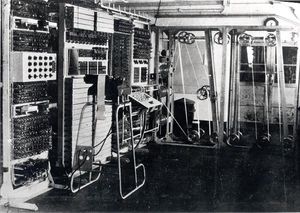Colossus: Difference between revisions
No edit summary |
No edit summary |
||
| Line 1: | Line 1: | ||
== Colossus == | == Colossus == | ||
[[Image: | [[Image:Colossus 0491.jpg|thumb|left|Colossus]]Although ENIAC is widely regarded as the first programmable computer, other contenders can make legitimate claims for that title. Perhaps the strongest case can be made for Colossus, a decrypting machine developed by the British during WWII. <br><br>As war raged, the Allies found themselves confronted with a complex German encryption cipher called Lorenz. Germany believed that the cipher was unbreakable. A computer and a group of dedicated British engineers proved them wrong. | ||
In December 1943, while work on ENIAC was just getting underway in Philadelphia, engineer Tommy Flowers delivered Colossus to British codebreakers working in top-secret conditions in England’s Bletchley Park. Colossus had an electronic memory, was programmable by means of switches and patch cords and could look for matching sequences that might help crack the code. Output was created by means of an IBM electric typewriter. | In December 1943, while work on ENIAC was just getting underway in Philadelphia, engineer Tommy Flowers delivered Colossus to British codebreakers working in top-secret conditions in England’s Bletchley Park. It began successful operations in January 1944. The machine, unlike ENIAC was designed for a specific task: military cryptanalysis. Colossus had an electronic memory, was programmable by means of switches and patch cords and could look for matching sequences that might help crack the code. Output was created by means of an IBM electric typewriter. | ||
Cracking the Lorenz cipher and being able to quickly translate captured orders and military plans helped change the course of the war and helped shorten it. Their near-miraculous secret work prompted British Prime Minister Winston Churchill to call the Bletchley Park codebreakers “the geese that laid the golden eggs and never cackled.” | Cracking the Lorenz cipher and being able to quickly translate captured orders and military plans helped change the course of the war and helped shorten it. Their near-miraculous secret work prompted British Prime Minister Winston Churchill to call the Bletchley Park codebreakers “the geese that laid the golden eggs and never cackled.” | ||
Revision as of 23:11, 30 December 2008
Colossus
Although ENIAC is widely regarded as the first programmable computer, other contenders can make legitimate claims for that title. Perhaps the strongest case can be made for Colossus, a decrypting machine developed by the British during WWII.
As war raged, the Allies found themselves confronted with a complex German encryption cipher called Lorenz. Germany believed that the cipher was unbreakable. A computer and a group of dedicated British engineers proved them wrong.
In December 1943, while work on ENIAC was just getting underway in Philadelphia, engineer Tommy Flowers delivered Colossus to British codebreakers working in top-secret conditions in England’s Bletchley Park. It began successful operations in January 1944. The machine, unlike ENIAC was designed for a specific task: military cryptanalysis. Colossus had an electronic memory, was programmable by means of switches and patch cords and could look for matching sequences that might help crack the code. Output was created by means of an IBM electric typewriter.
Cracking the Lorenz cipher and being able to quickly translate captured orders and military plans helped change the course of the war and helped shorten it. Their near-miraculous secret work prompted British Prime Minister Winston Churchill to call the Bletchley Park codebreakers “the geese that laid the golden eggs and never cackled.”
So why don’t more people know about Colossus? Because all the work at Bletchley Park, including Colossus, was top-secret, the buildings that housed the codebreaking activities were entirely cleaned out of any remnants of their wartime activity after the war. Codebreaking machines, including Colossus, were completely dismantled. Some of Colossus’ parts were reused in telegraph exchanges. Tommy Flowers even burned the blueprints of Colossus. All information relating to Bletchley Park was classified until the 1970s, and some is still classified. It was only during the last few decades that the contributions of those at Bletchley Park have become known and appreciated.
